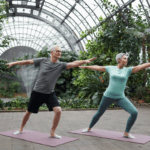Coming Soon: E-book about Kundalini Yoga - Sign up here to be among the first to get it!
Ever been in a Upward facing dog pose, feeling the stretch along your spine and the firm press of your palms against the mat? If you’ve attended yoga classes or dabbled with sun salutations at home, chances are you have. But how well do we truly know this foundational yoga pose? How can we make sure it’s serving us to its fullest potential?
This dynamic posture does more than just give our backs a deep stretch – it builds arm strength, opens up our chest for better breathing, and helps improve overall body posture. However, mastering Upward Facing Dog isn’t as simple as lifting yourself off the floor; proper alignment is key to avoiding wrist injuries and ensuring maximum benefits.
Are you hooked? Great, yogis! Let’s get ready to explore this flexible asana more. Let’s go through the procedure of executing this limber pose properly, step by step.
Table Of Contents:
- Understanding Upward Facing Dog
- How to Perform Upward Facing Dog
- Safety Precautions and Modifications in Upward Facing Dog
- Benefits of Practicing Upward Facing Dog Regularly
- Breath Control in Upward Facing Dog
- Variations of Upward Facing Dog Across Different Yoga Styles
- Troubleshooting Common Challenges in Upward Facing Dog
- FAQs about Upward Facing Dog
- Conclusion
Understanding Upward Facing Dog
The Upward Facing Dog pose, or Urdhva Mukha Svanasana in Sanskrit, is a key element of the Surya Namaskar series. It’s an integral part of many yoga classes and serves as one of the primary poses for building arm strength.
This dynamic posture actively draws energy from your entire body to create length in your spine while providing a deep stretch for your abdominal muscles. Regular practice can help relieve sciatica and improve overall posture.
A Gentle Backbend with Power
The Upward-Facing Dog pose is essentially a gentle backbend that challenges you to press firmly into the ground while lifting your thighs off the mat. When executed correctly, it engages not just your upper body but also creates space within hip joints, giving you more flexibility over time.
Your shoulder stretch here comes from letting them lift away from ears – this improves posture by strengthening upper chest muscles. As BKS Iyengar said: “The hard bow becomes useless when left continually strung up.”
Incorporating Into Your Practice
If practiced diligently and mindfully, Urdhva Mukha Svanasana offers numerous benefits including increased spinal mobility and stronger arms — helping counteract hours spent hunched at desks or steering wheels. A valuable addition to any vinyasa class indeed.
Note: While beginners might find this challenging initially due to required arm strength, they can start their journey towards mastering it through easier warm-up poses like Sphinx Pose or Cobra Pose before progressing further.
If you are a registered yoga teacher or even an enthusiastic practitioner, The Key Poses of Yoga is a must-have resource. It provides detailed explanations and diagrams to help deepen your understanding of each pose including Urdhva Mukha Svanasana.
How to Perform Upward Facing Dog
To start the upward-facing dog pose, also known as urdhva mukha svanasana in Sanskrit, position yourself on your belly with your legs extended straight behind you. Your hands should be positioned by your ribs, and ready for action.
Correct Hand Placement
Your palms need to press firmly into the mat under your shoulders with fingers spread wide apart. This helps distribute weight evenly across the hands instead of collapsing into wrists which could potentially lead to carpal tunnel syndrome or wrist injury over time.
In this yoga pose, make sure that elbows are slightly bent but not locked. Engage arm strength and lift your torso up off the ground while maintaining strong contact between palms and mat surface.
The proper alignment of the upper body in an upward facing dog is crucial for a deep stretch without causing strain or discomfort. A common mistake many practitioners make is dropping their shoulders too close to ears – remember to actively draw them back down towards hips creating space around the neck area thus relieving tension build-up there.
Finding Balance Between Strength And Flexibility
Engaging abdominal muscles can help stabilize the spine during this gentle backbend while simultaneously offering a stretch through the front side of the body from the throat down to the pubic bone (if done correctly).
You must also ensure thighs are lifted off the floor – only the tops of feet and palms should touch it; imagine trying to drag the chest forward against the resistance created by feet pressing into the ground to create length along the entire spine.
Maintaining Breath Control In The Pose
While in the upward facing dog pose, maintain a steady rhythm of breath. This not only helps calm the mind but also enables deeper immersion into the practice.
By breathing deeply and evenly while in the upward facing dog pose, you can relax your muscles to make the stretch more effective.
other things. Regular yoga classes can boost your flexibility, build arm strength, ease sciatica pain and enhance your posture. Many swear by the comprehensive approach to good health that yoga provides.
Master the Upward Facing Dog by starting on your belly, legs straight behind you. Press palms firmly into the mat under the shoulders, fingers spread wide to avoid wrist strain. Lift the torso using arm strength and keep elbows slightly bent. Engage abdominal muscles for stability and a full body stretch from throat to pubic bone – remember only tops of feet and palms should touch the ground. Breathe smoothly while holding this pose for maximum effect.
Safety Precautions and Modifications in Upward Facing Dog
When practicing the upward facing dog pose, or Urdhva Mukha Svanasana, safety should always be your top priority. With proper alignment, this yoga pose can strengthen your upper body and give you a deep stretch across the chest.
Preventing Wrist Injury
A common concern when performing upward facing dog is wrist strain. To avoid it, make sure to distribute weight evenly through both hands by pressing firmly into your mat. You might feel like all of the pressure is on your wrists, but try actively drawing power from other parts of your body too – such as pushing down with the tops of your feet or engaging abdominal muscles.
If you experience pain despite these precautions, consider modifying the pose. One way to do this is by using props for support – a rolled-up towel under each palm can help relieve pressure off wrists. Anatomy for Backbends and Twists covers more details about safe alignments and modifications.
Variations for Different Abilities
Different bodies require different adaptations; remember that every ‘body’ has its own unique set of strengths and limitations. If keeping legs extended throughout feels strenuous on lower back or hip joints, don’t hesitate to modify. A knees-down version reduces stress on these areas while still offering an effective shoulder stretch and upper chest opener.
If bending backward causes discomfort in the spine area due to conditions like sciatica pain relief could come from another variation where you use a chair’s edge instead of the floor – placing palms onto the seat surface and then stepping feet backward until the torso forms a straight line at a 45-degree angle downwards (also known as the “incline” position).
Upward facing dog is an integral part of many yoga classes and sequences like sun salutations or vinyasa class flows. But remember: safety first. Pay attention to your body’s indications and make the needed changes for an optimal experience.
When doing the Upward Facing Dog, safety comes first. To avoid wrist strain, spread your weight evenly and use other body parts like feet tops or abs. Modify if you feel pain; a towel under your palms can help. Different bodies need different variations – the knees-down version eases stress on the lower back and hips, while an ‘incline’ position using the chair’s edge is good for conditions like sciatica.
Benefits of Practicing Upward Facing Dog Regularly
The Upward-Facing Dog pose, or Urdhva Mukha Svanasana, is more than just a yoga move. It’s a boost for your energy and confidence, while also serving as an excellent stretch for your chest and abdomen.
This powerful pose strengthens the shoulders, arms, and back muscles – all key components in maintaining good posture. By practicing it regularly you can counteract slouching that results from daily activities such as working at a desk or using mobile devices.
Coping with Back Pain
If you’ve ever experienced lower back pain after long hours sitting in front of your computer screen, then the upward facing dog might be what you need to relieve this discomfort. This yoga pose helps to extend the spine which alleviates tension in the lower back area making it one of those warm-up poses that can significantly improve overall comfort during workdays.
Muscle Strengthening
In addition to relieving discomfort, regular practice offers strength training benefits too. With each repetition of Upward-Facing Dog within Sun Salutations sequence like Surya Namaskar B (the second sun salutation), shoulder blades are drawn together creating an open chest posture resulting in stronger arm muscles over time. Backing up the claims, even experts confirm them. Even experts like Natasha Rizopoulos, a well-known Yoga teacher, confirm these claims.
Better Posture & Confidence Boosts
Frequent practitioners report better body awareness leading to improved posture. Standing up straight not only has positive effects on physical health, but it can also give a lift to your self-esteem and assurance.
With the myriad benefits of practicing Upward Facing Dog, it’s no wonder this pose is a staple in yoga classes around the world. So grab your sticky mat and give it a try – you’ll thank yourself later for taking this step towards better overall wellness.
Regular practice of the Upward Facing Dog pose isn’t just a yoga routine. It’s your ticket to boosting energy and confidence, stretching your chest and abdomen, and strengthening shoulders, arms, and back muscles for good posture. It also helps alleviate lower back pain from long desk hours while making you stronger with each Sun Salutation sequence repetition. More so, it boosts body awareness leading to better posture and self-esteem levels. So start now. Your overall wellness will thank you later.
Breath Control in Upward Facing Dog
The Upward-Facing Dog, or Urdhva Mukha Svanasana as it’s known in Sanskrit, is a pose that calls for careful breath control. Coordinating your breathing with the movements of this pose can bring about maximum benefits.
Syncing with Breath
To sync your breath with the movements in the Upward Facing Dog Pose, you’ll need to be mindful of both the inhalation and exhalation phases. Start by lying on your stomach in a prone position. As you prepare to lift into the pose, take a deep inhale.
While exhaling, press firmly into your hands and the tops of your feet, lifting your torso and hips off the floor. Ensure to actively draw your shoulder blades onto your back while keeping your legs extended behind you.
Your body should now resemble an upward curve from head to heels – hence ‘Upward-Facing’. Keep breathing deeply at this stage; don’t hold it.
ClassPass provides some excellent resources for mastering these steps.
Mindful Breathing Techniques
You might find yourself gasping for air initially but remember: yoga isn’t just about getting through each posture—it’s also about how we breathe through them too.
Incorporate ‘Ujjayi Pranayama’, or the victorious breath technique—this involves taking slow, deep inhales followed by equally long exhales through the nose, creating a soothing sound almost like ocean waves hitting the shore—a helpful tip offered by the famous yogi B.K.S Iyengar himself.
Brett Larkin Yoga provides some great insights on Ujjayi Pranayama and other breathing techniques.
Our goal here is to make room for your breath. It’s just like how you’re extending your spine during the process.
Variations of Upward Facing Dog Across Different Yoga Styles
Yoga is a diverse practice, and as such, poses like the Upward-Facing Dog or Urdhva Mukha Svanasana, are interpreted differently across various styles. These variations can bring about subtle shifts in your body’s alignment and muscular engagement.
Vinyasa Flow vs Sun Salutation
In Vinyasa Flow yoga classes, practitioners move dynamically from one pose to another with each breath. The Upward Facing Dog Pose here serves as an integral part of this sequence, linking postures together for a smooth transition.
The focus in Vinyasa is often on creating length throughout the entire spine while actively pressing down through hands and tops of feet. This approach tends to engage more abdominal muscles than other styles which could be beneficial if you’re looking to build arm strength or relieve sciatica symptoms. Natasha Rizopoulos, an acclaimed vinyasa teacher explains it well.
Sun Salutations (Surya Namaskar) sequences also incorporate Urdhva Mukha Svanasana but its execution might differ slightly depending on the tradition followed. In some schools like Ashtanga or Iyengar (founded by BKS Iyengar), there’s more emphasis on using your upper chest strength to lift into the posture rather than just leveraging off your arms.
This interpretation allows for deeper shoulder stretch making it especially beneficial if you have tight shoulders due to excessive computer use or similar lifestyle habits.A gentle backbend in this style can provide relief for those suffering from carpal tunnel syndrome too.
Experiment with different styles until you find what feels right in your own body. Whether it’s a more dynamic vinyasa class or the measured pace of Sun Salutations, let your yoga journey be guided by personal experience rather than strictly following any single approach.
Upward Facing Dog, or Urdhva Mukha Svanasana, varies across yoga styles. Vinyasa Flow emphasizes lengthening the spine and engaging abdominal muscles, useful for building arm strength and relieving sciatica. Sun Salutations can stress using upper chest strength for a deeper shoulder stretch, beneficial if you’re dealing with tight shoulders or carpal tunnel syndrome. Remember to listen to your body and experiment until you find what feels right.
Troubleshooting Common Challenges in Upward Facing Dog
While the Upward Facing Dog pose, or Urdhva Mukha Svanasana, can feel invigorating and stretch your entire spine, it’s not without its challenges. Misalignment in this yoga pose can lead to shoulder elevation and lack of engagement in the legs.
Overcoming Shoulder Elevation
The first step is understanding why your shoulders lift during the upward facing dog pose. This typically happens when we fail to actively draw our shoulder blades towards our hips.
To fix this issue, imagine squeezing a pencil between your shoulder blades as you press firmly into your hands. This will help create space around your neck and ears while preventing unnecessary tension from building up.
Maintaining Leg Engagement
A common mistake beginners make is allowing their thighs to touch the ground during Urdhva Mukha Svanasana. However, keeping them lifted off the mat helps engage leg muscles fully and protects lower back health.
You’ll find that using a sticky mat under your feet provides enough traction for maintaining good form throughout each repetition of sun salutations within vinyasa classes or even when practicing independently at home with resources like the Outside+ app available on the link here.
Safeguarding Your Wrists
Carpal tunnel issues often stem from improper hand placement which puts undue pressure on wrists over time especially if downward facing dog follows immediately after urdhva mukha svanasana in your sun salutation series.
To alleviate wrist stress, try to distribute weight evenly across the entire palm. Also, actively press into the base of each finger and thumb rather than just dumping all body weight onto wrists directly. You can always seek guidance from registered yoga teachers during classes or workshops to improve your form further.
Mastering the Upward Facing Dog pose means overcoming common hurdles. Keep shoulders down by pretending to squeeze a pencil between your shoulder blades, and make sure your thighs don’t touch the ground for full leg engagement. Use a sticky mat for better form and spread weight evenly on palms to avoid wrist stress.
FAQs about Upward Facing Dog
What is the difference between Cobra and upward facing dog?
Cobra pose keeps your hips on the mat, focusing more on a gentle backbend. In contrast, Upward Facing Dog lifts your thighs off the mat for a deeper stretch in your chest and abdomen.
What are the correct alignment cues for upward facing dog?
Your hands should be under your shoulders, legs straight out behind you. Push through palms to lift the torso up while keeping elbows close to the body. Draw your shoulder blades down as you extend your neck.
Why is downward facing dog so difficult?
The difficulty comes from needing strength and flexibility simultaneously – it works your arms, shoulders, hamstrings, and calves all at once. Also maintaining proper alignment can be challenging for beginners.
How to do up dog correctly?
Lay flat on the stomach with hands by the sides of the waistline. Press into palms while straightening arms; lift upper body and thighs off the floor. Keep your gaze forward or slightly upwards without straining the neck.
Conclusion
Exploring the Upward Facing Dog, we’ve discovered it’s more than just a stretch. It builds arm strength, improves our breathing, and boosts overall posture.
We delved into its proper alignment to protect our wrists and maximize benefits. We realized the importance of hand placement, how breath control amplifies its power, and modifications that can make this pose accessible for everyone.
Different yoga styles bring unique twists to Upward Facing Dog – an exciting discovery! Troubleshooting common challenges? Now you’re equipped with techniques to conquer them all!
The journey doesn’t end here though. Keep practicing, keep exploring your boundaries in safety – because each day on the mat is a step towards better health and inner peace.
Sign up for our newsletter to stay updated with the latest articles, or ask me anything!




